Contents
|
|
Introduction
Directed trades allow you to focus on individual securities while giving you the option of trading across a group of accounts outside the constraints of a rebalance. However, directed trades can also be used in conjunction with completing a rebalance on your accounts.
Directed trades are usually created because of a trigger of some kind, whether that's selling out of one security in favor of another, buying a security to take advantage of a particular opportunity, or selling out of a security as a result of some market force. Directed trades provide you with a way to create those targeted trades that can be carried out quickly.
For more information on specific strategies that can be used with directed trades, see Strategies Using Directed Trades and Directed Trades Versus Rebalancing.
Directed Trades Process Overview
When creating a directed trade, the options you choose depend on your strategy, but the basic process is the same:

Step 1: Identify Accounts
Find all of the accounts in which you want to complete a directed trade. This is often done through creating a saved search to target accounts that meet certain criteria.
Best Practices
Create a saved search before generating a directed trade to save time. Here are some example saved searches you can create before generating a directed trade:
-
Accounts using a specific Security Level model. The search below is identifying accounts that are using the U.S. Large Cap Equities model.

-
Accounts using a specific Allocation model. The search below is identifying accounts that are using the 60/40 Allocation Model.

-
Accounts containing a specific security. The search below is identifying all accounts that contain ADM.

There are many other options for saved search criteria which you can use to identify accounts needed in a directed trade. For more information on creating a saved search, see Learn More About Searching for Accounts.
Step 2: Create the Directed Trades
After you've identified accounts, the next step is to create the directed trade using the options most suited for your goals. This includes selecting the security you'll be trading, the quantity you'll be trading, and the quantity type.
Example
The following is an example of a directed trade being created to sell 100% of MSFT.
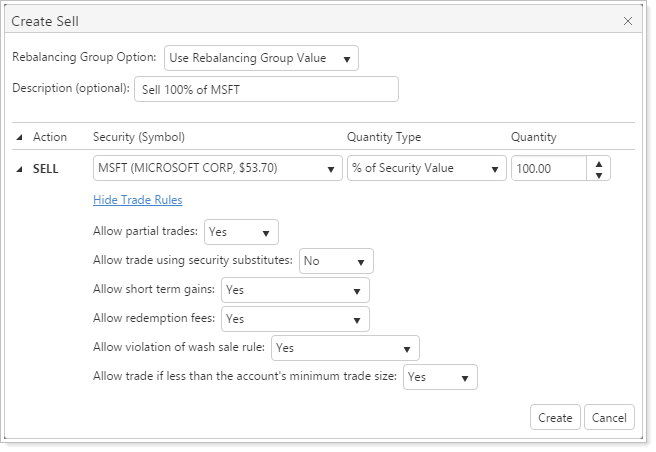
See Create a New Directed Trade for instructions on creating a trade. For more information on the trade types available in directed trades, see Trade Type and Quantity Definitions in Directed Trades.
Step 3: Add Accounts
Once you create the directed trade, you'll then associate the trade with the correct accounts. Usually this is done by associating the directed trade with a saved search you've already created, but this can also be done by picking individual accounts.
Best Practices
You can create multiple directed trades using the same saved search.
For more information on adding accounts, see Add Accounts and Apply a Directed Trade.
Step 4: Apply Trade
Once the trade has been created and all appropriate accounts are added, the next step is to complete the trade. Once the directed trade has been saved and applied, it will appear on the Trade Review page.
Best Practices
To review the directed trade in greater detail, you can use filtering on the Trade Review page. Filter by the directed trade created to see more detail about the trades created, including account-level details.

After applying the trade, you'll then review and apply the trade.
Directed Trade Types and Rules
Directed trades are completed using trade and quantity types, each with their own behavior based on the options you select. Consider the following rules when creating a directed trade:
Important Information
-
Advisor Rebalancing adheres to the account’s round lot size unless a dollar or share amount for the security is specified. Trades that are less than one round lot are not recommended.
-
When directed trades are applied to an account that needs to raise cash and the net amount of the trades is not enough to cover the cash needs, the trades will not be recommended.
-
Trades will execute to the extent of available cash. If you have three buys pending, but only have cash available for two, the first two buys will execute; the third buy will not execute because of insufficient cash.
For more information on trade types and their behavior, see Trade Type and Quantity Definitions in Directed Trades.
Create a New Directed Trade
To create a directed trade, follow these steps:
-
On the Rebalance & Trade menu, choose Directed Trades.
-
In the Trade Type list, choose the applicable trade type and click Create.
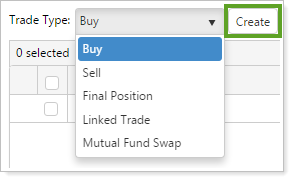
For more information, see Trade Type and Quantity Definitions in Directed Trades.
-
In the Rebalancing Group Option list, choose one of the following:
Use Rebalancing Group Value. Trades at the rebalancing group level. Advisor Rebalancing will select the best account in which to execute the trade and the trade will be calculated at the rebalancing group or household level.
Use Underlying Account Value. Trades at the individual account level.
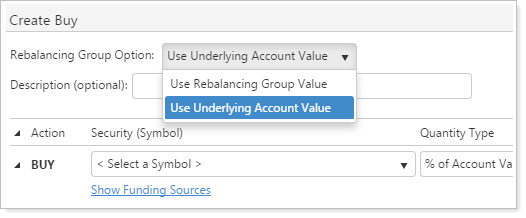
For more information, see Trade Type and Quantity Definitions in Directed Trades.
-
Enter an optional description in the Description field.
-
In the Select a Symbol list, click the down arrow and then type the ticker in the box that appears. If you selected Linked Trade or Mutual Fund Swap, note that the buys and sells are separated on the screen.

-
In the Quantity Type list, choose the appropriate type for the directed trade. For a full description of the quantity types, see Trade Type and Quantity Definitions in Directed Trades.
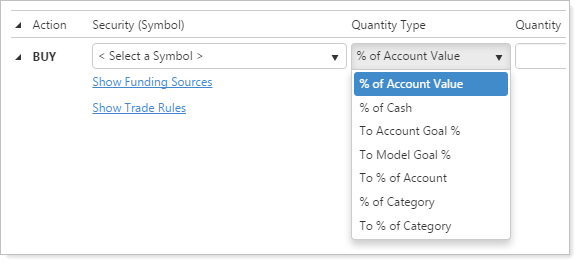
-
In the Quantity box, type the quantity you want to buy or sell.
Note
If you're using the Sell Losses or Sell Gains quantity type, you won't be able to enter anything in the Quantity box. Instead, you'll enter a percentage of loss/gain and dollar amount of loss/gain to serve as your thresholds for the directed trade.
-
In the Priority box, choose the priority of the directed trade. Advisor Rebalancing processes priority 1 first and then the rest of the trades in numerical order.

-
The Show Funding Source link appears for trades that include buys. Click the link to add a security or securities to a list that will be sold to generate cash for the buy. You can also specify the sell order using the up and down arrows.

-
Click the Show Trade Rules link and specify the trade rules for this directed trade.
Trade Rule More Information Allow partial trades Choose how the directed trade will handle any resulting partial trades. Allow trade using security substitutes Choose whether the directed trade will use any security substitutes you've created for the traded security. Allow short term gains Choose how the directed trade will handle each account's short term gain setting. Allow redemption fees Choose how the directed trade will handle each account's redemption fee setting. Allow violation of the wash sale rule Choose how the directed trade will handle each account's wash sale rule setting. Allow trade if less than the account's minimum trade size Choose how the trade will handle each account's minimum trade size settings. Allow trade if less than the minimum investment setting Choose how the trade will handle a security's minimum investment setting. Notes
-
The trade rules you see will change based on the type of directed trade you choose, so only the trade rules that apply to your particular directed trade will appear.
-
The trade rules you set here will override the defaults you have set on the System Settings page. For more information on the logic of these trade rules, see Directed Trade Settings.
-
-
Click Create. Advisor Rebalancing will create the directed trade. Next, you'll want to add accounts to which you want to apply the directed trade.
Add Accounts and Apply a Directed Trade
After creating a directed trade, add the accounts or rebalancing groups in which you want to apply the trade you created.
Important Information
-
There is no limit to the number of accounts you can add to a directed trade.
-
If you created a directed trade, others may be able to view and execute the trade but you are the only person who may add accounts to that trade.
-
Creating a saved search allows you to isolate a specific set of accounts based on selected criteria. This is an efficient way to select accounts to create a directed trade. For more information, see Learn More About Searching for Accounts.
-
On the Rebalance & Trade menu, choose Directed Trades.
-
Add accounts using one of these methods:
-
Select the check box next to the trade you want to add. Click Add Accounts in the More Actions list and click Continue.
-
Click the blue 0 link in the Accounts column.

-
-
Check the box next to accounts where you want to apply the directed trade and then click Save & Apply. You can use the Saved Search and Account Set lists to filter the accounts you see.
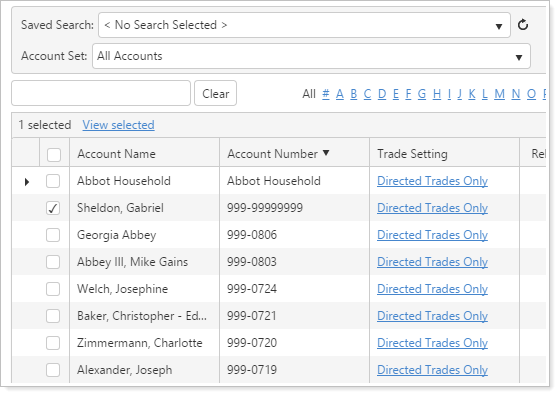
-
Select the check box next to any directed trades you want to execute. In the More Actions list, choose Set Trade Setting and then click Continue.
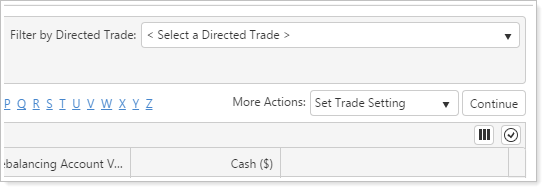
-
Choose a trade setting for the directed trade. You can choose whether to process the directed trade only or whether to process the directed trade and then rebalance the account. Choose the appropriate option and then click Save.
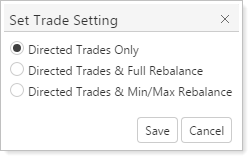
-
Click Save & Apply. Advisor Rebalancing will send the trades to the Trade Review page for your approval.
Make Changes to a Directed Trade
Once a directed trade has been created, you can make changes to it. You can change the associated accounts or change the details of the directed trade itself.
Edit a Directed Trade
To make changes to an existing directed trade, follow these steps:
-
On the Rebalance & Trade menu, choose Directed Trades.
-
Click the description of the directed trade you want to edit.
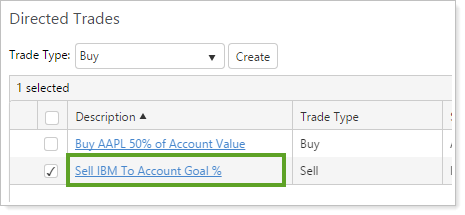
-
Make the necessary changes and then click Save & Apply.
Change or Remove Accounts from a Directed Trade
To remove an account from being applied to a directed trade, follow these steps:
-
On the Rebalance & Trade menu, choose Directed Trades.
-
Select the check box next to the directed trade where you want to remove accounts. Choose one of the following actions:
-
To remove some of the accounts, click Remove Accounts in the More Actions list and then click Continue.

-
To remove all of the accounts, click Remove All Accounts in the More Actions list and then click Continue.
-
To change accounts and see which accounts have already been added, click the blue link in the Accounts column. Make your changes and click Save & Apply.
-
Reapply a Directed Trade
The Reapply Trades option allows you to save and rebalance all of the accounts assigned to a directed trade so you won't have to complete a directed trade and then later rebalance the same accounts.
Notes
-
If you change the details of the directed trade, Reapply Trades reapplies the trade to all accounts within the directed trade rather than just those accounts which contain the change. The benefit of this option is that it will always reapply the trade whether changes have been made or not.
-
If you remove the directed trade on the Rebalance Review page, this removes accounts on the Trade Review page as well. However, Reapply Trades will still reapply the trade to every account included in the trade.
To use this option, follow these steps:
-
On the Rebalance & Trade menu, choose Directed Trades.
-
Select the check box next to the directed trade where you want to reapply a trade.
-
In the More Actions list, click Reapply Trades. Click Continue.
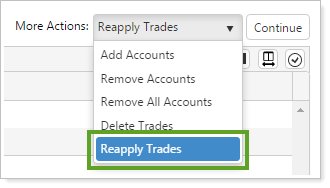
-
Click Reapply on the message window to continue.
Delete a Directed Trade
Any time a deletion or edit is executed, Advisor Rebalancing reprocesses the accounts to ensure the accuracy of the trades.
Best Practices
When possible, all deletions or edits to directed trades should be made at the same time for efficiency.
To remove a directed trade, follow these steps:
-
On the Rebalance & Trade menu, choose Directed Trades.
-
Select the directed trade you want to delete.
-
In the More Actions list, choose Delete Trades, and then click Continue.

-
On the confirmation dialog, click Delete.


